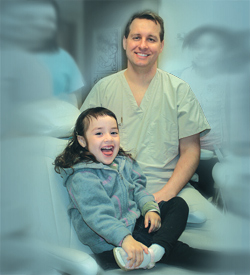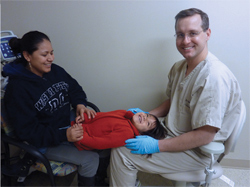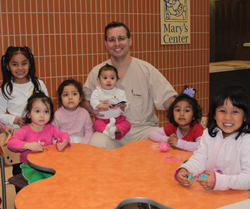 Mary’s Center: In the heart of the capital, an enclave of excellence Awesome toys, novelty chairs with buttons, and a shiny new facility: even veteran patients would find dental treatment at Mary’s Center more fun than frightening. For Rich Gesker, DMD, that’s precisely the point. Dr. Gesker, the center’s chief dental officer, oversees the care of some 3,500 largely low-income children in the District of Columbia. Dr. Gesker’s role at Mary’s Center for Maternal and Child Care is his first involving pediatric patients. Completely familiar to him, however, is the commitment to pain-free oral care. Since beginning his dentistry career a decade ago, Dr. Gesker has sought to upend negative stereotypes. Parental horror stories, movie clichés or scary childhood experiences often transform anticipatory anxiety into downright dread. Such sensations can and do amplify discomfort and pain, complicating treatment for patient and dentist alike, Dr. Gesker says. “The cycle of fear is something I try very hard to break,†he adds, “but my training from DOCS Education makes it so much easier.†Focus on comprehensive treatment Given the size of his current patient base, the task seems formidable. Assisting Dr. Gesker are two hygienists, volunteer dentists, interns from Georgetown University and the George Washington University, and students from Howard University’s College of Dentistry. Dr. Gesker also finds support in the center’s longstanding focus on prevention and health promotion. “We don’t believe in putting good dental work within a diseased mouth and uneducated mindset,†Dr. Gesker explains, praising the emphasis hygienists and others place upon proper nutrition, brushing and flossing. “Our objective isn’t damage control, but rather comprehensive treatment. Obtaining dental stability is an essential step to achieving that goal.†Founded in 1988 to treat the medically underserved, Mary’s Center offers maternal/child, mental health, teen and dental care. Its core strategy combines social services, advocacy and a helping hand. The unified approach is extended to approximately 18,000 individuals and families. Patients hail from Central and South America, Asia, and a variety of African nations. Mary’s Center staff members are “among the most compassionate colleagues I’ve ever worked with. They strive not only to provide first-rate clinical care, but also positive health outcomes. Our mission is to improve the lives of patients even after they have left the office,†Dr. Gesker says. Caries - most common chronic infectious disease of childhood Along with counterparts elsewhere, Mary’s Center pediatric patients show skyrocketing caries rates fueled by poor dietary habits. Theirs is far from an isolated trend. In fact, sharp increases in caries among children are worrying dentists throughout the nation. According to DOCS Education faculty member Roger Sanger, DDS, MS, caries are “an unaddressed epidemic that now outpaces asthma and other chronic conditions.†The subject of an article published in the April issue of the Journal of Clinical Microbiology, caries are described as the most common chronic infectious disease of childhood in the United States, capable of destroying primary teeth, causing painful abscesses and hospital visits. Caries’ effects disproportionately punish disadvantaged socio-economic groups, the Journal article concludes. The caries crisis caught many in the dental community by complete surprise, Dr. Sanger says. “I began my career imagining I would be made obsolete by the availability of fluoride. I never expected to see that advantage undone by the onslaught of sugary drinks and unhealthy snacks.†Dr. Sanger, who founded one of California’s largest pediatric specialty practices, considers parents the unwitting ally of poor health habits. “It saddens me to see mothers and fathers pass their own poor eating habits to a new generation.†Dr. Sanger’s group treats children and teens from a wide variety of socio-economic backgrounds. Lack of pediatric dentists The lack of pediatric dentists should signal a clarion call to the profession, Dr. Sanger says. “Fortunately it doesn’t always take a specialist to offer specialty care. The right training and equipment, mentorship, and resources can prepare a practice to offer this vital service.â€
Mary’s Center: In the heart of the capital, an enclave of excellence Awesome toys, novelty chairs with buttons, and a shiny new facility: even veteran patients would find dental treatment at Mary’s Center more fun than frightening. For Rich Gesker, DMD, that’s precisely the point. Dr. Gesker, the center’s chief dental officer, oversees the care of some 3,500 largely low-income children in the District of Columbia. Dr. Gesker’s role at Mary’s Center for Maternal and Child Care is his first involving pediatric patients. Completely familiar to him, however, is the commitment to pain-free oral care. Since beginning his dentistry career a decade ago, Dr. Gesker has sought to upend negative stereotypes. Parental horror stories, movie clichés or scary childhood experiences often transform anticipatory anxiety into downright dread. Such sensations can and do amplify discomfort and pain, complicating treatment for patient and dentist alike, Dr. Gesker says. “The cycle of fear is something I try very hard to break,†he adds, “but my training from DOCS Education makes it so much easier.†Focus on comprehensive treatment Given the size of his current patient base, the task seems formidable. Assisting Dr. Gesker are two hygienists, volunteer dentists, interns from Georgetown University and the George Washington University, and students from Howard University’s College of Dentistry. Dr. Gesker also finds support in the center’s longstanding focus on prevention and health promotion. “We don’t believe in putting good dental work within a diseased mouth and uneducated mindset,†Dr. Gesker explains, praising the emphasis hygienists and others place upon proper nutrition, brushing and flossing. “Our objective isn’t damage control, but rather comprehensive treatment. Obtaining dental stability is an essential step to achieving that goal.†Founded in 1988 to treat the medically underserved, Mary’s Center offers maternal/child, mental health, teen and dental care. Its core strategy combines social services, advocacy and a helping hand. The unified approach is extended to approximately 18,000 individuals and families. Patients hail from Central and South America, Asia, and a variety of African nations. Mary’s Center staff members are “among the most compassionate colleagues I’ve ever worked with. They strive not only to provide first-rate clinical care, but also positive health outcomes. Our mission is to improve the lives of patients even after they have left the office,†Dr. Gesker says. Caries - most common chronic infectious disease of childhood Along with counterparts elsewhere, Mary’s Center pediatric patients show skyrocketing caries rates fueled by poor dietary habits. Theirs is far from an isolated trend. In fact, sharp increases in caries among children are worrying dentists throughout the nation. According to DOCS Education faculty member Roger Sanger, DDS, MS, caries are “an unaddressed epidemic that now outpaces asthma and other chronic conditions.†The subject of an article published in the April issue of the Journal of Clinical Microbiology, caries are described as the most common chronic infectious disease of childhood in the United States, capable of destroying primary teeth, causing painful abscesses and hospital visits. Caries’ effects disproportionately punish disadvantaged socio-economic groups, the Journal article concludes. The caries crisis caught many in the dental community by complete surprise, Dr. Sanger says. “I began my career imagining I would be made obsolete by the availability of fluoride. I never expected to see that advantage undone by the onslaught of sugary drinks and unhealthy snacks.†Dr. Sanger, who founded one of California’s largest pediatric specialty practices, considers parents the unwitting ally of poor health habits. “It saddens me to see mothers and fathers pass their own poor eating habits to a new generation.†Dr. Sanger’s group treats children and teens from a wide variety of socio-economic backgrounds. Lack of pediatric dentists The lack of pediatric dentists should signal a clarion call to the profession, Dr. Sanger says. “Fortunately it doesn’t always take a specialist to offer specialty care. The right training and equipment, mentorship, and resources can prepare a practice to offer this vital service.† The fact that low-income children are especially affected by caries offers another powerful testament to the value of Mary’s Center, Dr. Gesker believes. “We have a responsibility to intervene and protect these children from unwanted dental disease.†Dr. Gesker credits DOCS Education and Dr. Sanger with giving him the academic training necessary to care for pediatric patients. Operating on an annual budget of $20 million, Mary’s Center now manages two facilities in Washington, DC. Proximity to the White House and Congress has earned the center a battalion of high-profile supporters, including Department of Health and Human Services Secretary Kathleen Sebelius and First Lady Michelle Obama. Celebrity cache aside, it was Mary’s Center’s dedication to quality care and a state-of-the-art physical environment that drew Dr. Gesker. “I don’t believe income status should determine the kind of care that a person receives. This clinic offers a very high caliber of service and the same range of advanced dental procedures you’d find elsewhere.†In addition to new technology and modern operatories, the center prides itself on current philosophies, such as adopting the guiding principles of medical and dental homes. These terms may seem homespun, but they in fact illustrate contemporary national thinking about how to coordinate the care of children and families—mainly by consolidating treatment within strong centers organized around pediatric expertise. The American Academy of Pediatric Dentistry reaffirmed its support for dental homes last year. The dental home model minimizes the financial burden on Medicare, Dr. Gesker says, because it reduces costs as a result of lowered overhead and operational and practice management efficiencies. Being named one of the country’s 1,200 federally qualified health centers has placed Mary’s Center at the “paperless vanguard,†because such a designation carries with it a system of electronic medical records, explains Dr. Gesker. Prior to arriving at Mary’s Center in 2010 Dr. Gesker was a naval officer practicing dentistry in a high-volume military environment. He also directed a practice management group focusing on customer service. He sees his current role as a hybrid of previous ones, and considers Mary’s Center dental care a replicable model. “We believe our approach can be quickly adopted by anyone wishing to better their standards, improve the provision of fundamental care and control Medicaid costs.†Systemic improvements—including sedation—-offers wide range of services
The fact that low-income children are especially affected by caries offers another powerful testament to the value of Mary’s Center, Dr. Gesker believes. “We have a responsibility to intervene and protect these children from unwanted dental disease.†Dr. Gesker credits DOCS Education and Dr. Sanger with giving him the academic training necessary to care for pediatric patients. Operating on an annual budget of $20 million, Mary’s Center now manages two facilities in Washington, DC. Proximity to the White House and Congress has earned the center a battalion of high-profile supporters, including Department of Health and Human Services Secretary Kathleen Sebelius and First Lady Michelle Obama. Celebrity cache aside, it was Mary’s Center’s dedication to quality care and a state-of-the-art physical environment that drew Dr. Gesker. “I don’t believe income status should determine the kind of care that a person receives. This clinic offers a very high caliber of service and the same range of advanced dental procedures you’d find elsewhere.†In addition to new technology and modern operatories, the center prides itself on current philosophies, such as adopting the guiding principles of medical and dental homes. These terms may seem homespun, but they in fact illustrate contemporary national thinking about how to coordinate the care of children and families—mainly by consolidating treatment within strong centers organized around pediatric expertise. The American Academy of Pediatric Dentistry reaffirmed its support for dental homes last year. The dental home model minimizes the financial burden on Medicare, Dr. Gesker says, because it reduces costs as a result of lowered overhead and operational and practice management efficiencies. Being named one of the country’s 1,200 federally qualified health centers has placed Mary’s Center at the “paperless vanguard,†because such a designation carries with it a system of electronic medical records, explains Dr. Gesker. Prior to arriving at Mary’s Center in 2010 Dr. Gesker was a naval officer practicing dentistry in a high-volume military environment. He also directed a practice management group focusing on customer service. He sees his current role as a hybrid of previous ones, and considers Mary’s Center dental care a replicable model. “We believe our approach can be quickly adopted by anyone wishing to better their standards, improve the provision of fundamental care and control Medicaid costs.†Systemic improvements—including sedation—-offers wide range of services  “Systemic improvements generally pave the path to sustainability,†Dr. Gesker explains. “That’s why the ability to offer a range of services, for example sedation, is so important. We’re confident we’ll become a clinic that’s the first choice of many patients.†Patients with private insurance help recoup the cost of those without, Dr. Gesker explains. “For every privately insured patient, the costs of treating two who are underserved is offset.†Individuals with low or no incomes pay according to a sliding scale, and there’s a minimum fee of $10. Patients seem universally pleased to pay the $10, which carries both obvious and not-so-obvious benefits. “Not only does that charge rarely go unpaid, it ensures people keep their appointments. No-shows haven’t proved to be a problem.†Of course, payer mix and practice efficiencies carry little if any weight with Dr. Gesker’s pediatric clientele. Fortunately there are other ways to engage them. “I always put kids in charge of adjusting their own chairs. That’s wildly popular,†he says. The ability to offer sedation to children represents a vital treatment option, Drs. Sanger and Gesker say. They note that numerous caries, combined with frantic adult work schedules, can jeopardize prolonged treatment plans. Sedation may tip the balance between successfully completing comprehensive care and failing to address a child’s oral health needs at all. “Children deserve the option of pain relief as much as any other patients,†Drs. Gesker and Sanger say. Dr. Gesker credits his DOCS Education affiliation not only with teaching him new procedures but also expanding his view of dentistry. “I have taken over 60 hours of courses and find the quality of instruction extraordinarily high. The qualifications I’ve gained from the program have helped me develop an effective model at Mary’s Center.†Involvement with DOCS Education “has simply made me a better dentist and transformed my career,†Dr. Gesker says.
“Systemic improvements generally pave the path to sustainability,†Dr. Gesker explains. “That’s why the ability to offer a range of services, for example sedation, is so important. We’re confident we’ll become a clinic that’s the first choice of many patients.†Patients with private insurance help recoup the cost of those without, Dr. Gesker explains. “For every privately insured patient, the costs of treating two who are underserved is offset.†Individuals with low or no incomes pay according to a sliding scale, and there’s a minimum fee of $10. Patients seem universally pleased to pay the $10, which carries both obvious and not-so-obvious benefits. “Not only does that charge rarely go unpaid, it ensures people keep their appointments. No-shows haven’t proved to be a problem.†Of course, payer mix and practice efficiencies carry little if any weight with Dr. Gesker’s pediatric clientele. Fortunately there are other ways to engage them. “I always put kids in charge of adjusting their own chairs. That’s wildly popular,†he says. The ability to offer sedation to children represents a vital treatment option, Drs. Sanger and Gesker say. They note that numerous caries, combined with frantic adult work schedules, can jeopardize prolonged treatment plans. Sedation may tip the balance between successfully completing comprehensive care and failing to address a child’s oral health needs at all. “Children deserve the option of pain relief as much as any other patients,†Drs. Gesker and Sanger say. Dr. Gesker credits his DOCS Education affiliation not only with teaching him new procedures but also expanding his view of dentistry. “I have taken over 60 hours of courses and find the quality of instruction extraordinarily high. The qualifications I’ve gained from the program have helped me develop an effective model at Mary’s Center.†Involvement with DOCS Education “has simply made me a better dentist and transformed my career,†Dr. Gesker says.
issue_no
1
The information contained in this, or any case study post in Incisor, should never be considered a proper replacement for necessary training and/or education regarding adult oral conscious sedation. Regulations regarding sedation vary by state. This is an educational and informational piece. DOCS Education accepts no liability whatsoever for any damages resulting from any direct or indirect recipient's use of or failure to use any of the information contained herein. DOCS Education would be happy to answer any questions or concerns mailed to us at 3250 Airport Way S, Suite 701 | Seattle, WA 98134. Please print a copy of this posting and include it with your question or request.




